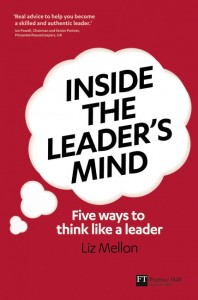A book that many CEOs would like all their employees to read is Inside the Leader’s Mind: Five Ways to Think Like a Leader by Liz Mellon.
After 25 years of leadership development experience, the author decided to study 20 world-class leaders to find out how they really think.
What the author found were five thinking styles that most effective leaders have in common, and she presents them in a way that can help you to evolve your thinking and become a better leader. Unlike other leadership books that focus on behaviours and personalities, Inside the Leader’s Mind emphasises how leaders think. But it is not a behavioural recipe or a “cookie cutter” for success. It is a menu _ and what you choose and how you react will be as individual as you are.
“You don’t need to take these steps in any particular order. Think of them as dance steps to be mastered. They aren’t steps to be laboriously climbed or arduously sequenced,” the book says.
Leaders try to think in all five ways simultaneously. Here they are:
A. No safety net: The first step is to recognise you are alone, as no one else will likely see the opportunities that you can or have the courage to grasp them.
The second is to be brave enough to take the first step into the unknown.
Third, ensure you don’t get too far ahead of your followers.
Fourth, keep alert to danger by maintaining a healthy sense of self-doubt.
Finally, you can’t be afraid to fail.
B. Comfortable in discomfort: First, as a leader sometimes you will have to operate in a grey area, where you may not have all the data you need to take a decision. It’s about instinct and speed _ but it’s not about assuming the future will be the same as the past.
Second, you need to learn to love ambiguity: we live in a “yes, and …” world, rather than an “either-or” world.
Third, paradoxically sometimes it’s about delaying a decision _ keeping an open mind. Regardless of whether you have enough data, the timing of the decision has to be right, and sometimes this means keeping a decision open even when others are urging you to decide.
Fourth, you need to be comfortable with surprising people from time to time _ you won’t always be predictable.
Finally, despite all the uncertainty you have to be able to explain your decisions in a way that makes sense to others even though the logic may not be clear even to you. Your followers need a sense of direction and purpose.
C. Solid core: This means even if you don’t know where you are going, you need to understand where you are coming from. You have to have a clear inner consciousness, values and character. You need an inner compass that can keep you on the right path.
D. On my watch: You consciously allocate effort to be spent on the past, present and future rather than spending too much effort only today’s firefighting. Thinking about the past means respecting and integrating the history of the organisation into today’s thinking. It also means you respect the past that your followers created. An example of this thinking is Jacko Maree, the group chief executive of Standard Bank. He told the author he spends 15% on the past, 50% on the present and 35% on the future.
E. “I am the enterprise”: First, you represent the organisation to so many people, both inside and outside the enterprise, that you have to be highly self-aware and manage the person that others see. Be the leader they need.
Second, you must love the enterprise. You must have passion, conviction and commitment to it.
Third, you understand that although you love the enterprise, it is not yours to control.
Fourth, you live the organisational values. If you were an outsider, you can blend into the organisational DNA.
Finally, if something goes wrong you are prepared to take the responsibility. You are willing to step down from your job if it will make your organisation a better place or make it better placed to survive, however unfair it may feel.
There are three ways in which you can develop these five ways of thinking. You can do it one at a time or integrate them as you wish.
– You can change your way of thinking directly.
– You can get a coach.
– You can take on a big leadership assignment and get your boss to support you. For example, a chief executive who wants to become more “comfortable in discomfort” may apply for an opportunity to be posted to another country where he learns how work with different cultures and backgrounds.
For anyone wanting to learn about the types of thinking that make good leaders, I recommend this book.


